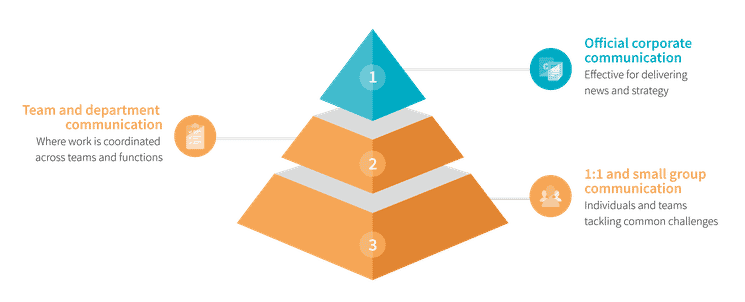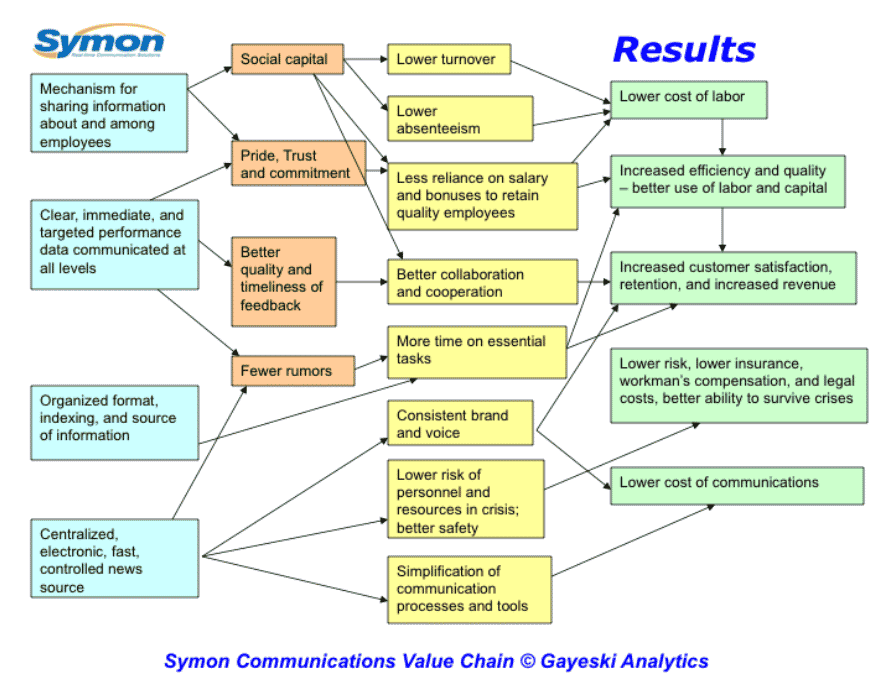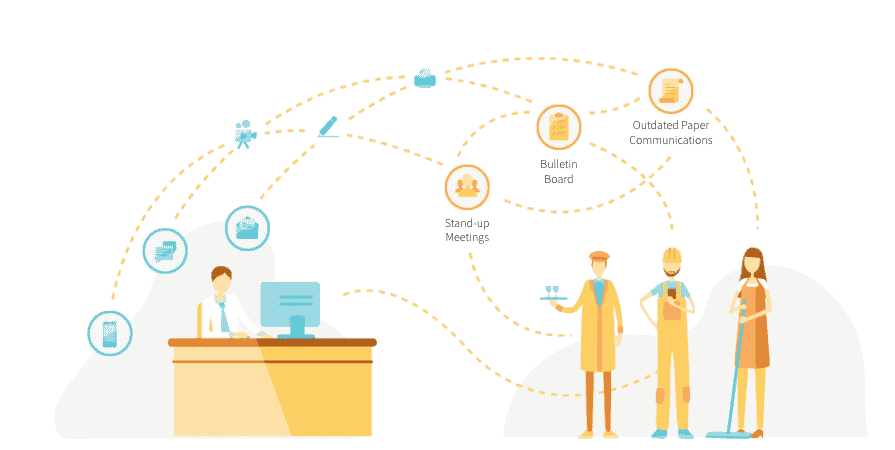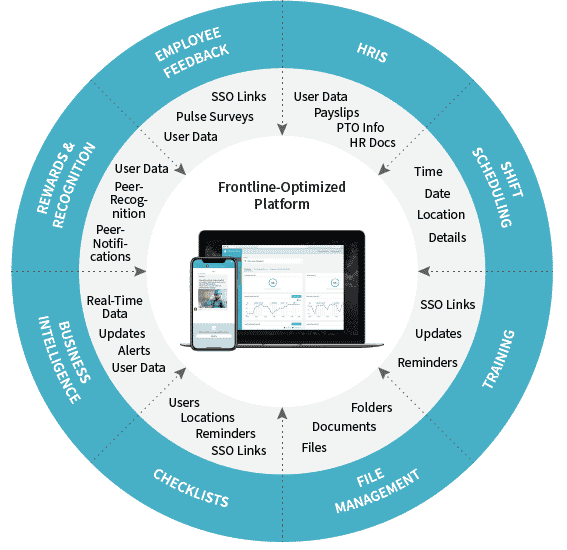Welcome to part two of our Frontline Future of Work Series (FFOW) series! If you haven’t read FFOW Part 1 | The Reality of Being a Frontline Worker: Who Are They and What Do They Need? check it out now. For part two, let’s talk about the difference between top-down internal communication and operational communication and why the latter is the future of how frontline workers will communicate.
As any relationship expert will tell you, communication is key to a healthy partnership. This holds true beyond our personal lives. In fact, it’s part of the foundation upon which successful companies build their cultures. As times change, however, so too do the ways we communicate. In this unprecedented cultural moment we’re all experiencing, the nature of how we relate to each other and share information and ideas has fundamentally shifted.
As Greek philosopher Epictetus proposed in the first century A.D, “We have two ears and one mouth so that we can listen twice as much as we speak.” We also have smartphones and apps that can empower communication in ways Epictetus and his crew never anticipated — yet his observation still rings true.
The Importance of Empowering Frontline Workers
Frontline workers are being subjected to on-the-job experiences that no job description could have prepared them for. Often they’re asked to ramp up productivity to meet market demands that were unheard of just a few months ago.

Throughout all this, frontline workers are also tasked with being the face of the company. They’re asked to interact with customers as de facto brand ambassadors at a time when two social phenomena are at play:
- When working in spaces that require interaction with the public, frontline workers are inherently at greater risk for contagions like the coronavirus.
- Tensions are high due to a number of social issues, which can lead to frontline workers being subjected to verbal abuse and occasional acts of violence from customers.
Social media is rife with videos of people projecting their worst behavior onto frontline workers who are asked to enforce company policies that provoke these bad actors (such as wearing a mask while shopping). Given the nature of frontline workers’ present experience, their employers have both an opportunity (and responsibility) to engage and empower their frontline staff.
“According to Gallup’s State of the Global Workplace, only 15% of employees are engaged in the workplace. In particular, frontline workers are under incredible pressure during the coronavirus.”
– Marie Gettel-Gilmartin, Founder and Owner, Fertile Ground Communications.
Besides the physical stressors frontline workers face, their occupations also take a mental toll according to recent findings. Researcher Jianbo Lai of the First Affiliated Hospital of Zhejiang University School of Medicine in Hangzhou, China, recently authored a study for his university’s department of psychiatry which found that frontline workers are 52% more likely to experience depression.
Overall, Lai’s research indicated that 50.4% of frontline workers surveyed experienced symptoms of depression. 44.6% had symptoms of anxiety. 34% reported symptoms of insomnia, and 71.5% reported “feelings of distress.”
Likewise, 18% of frontline healthcare workers who experienced depression had a severe form of the condition, compared with 12.9% of second-line workers.
Given these daunting statistics, the more that can be done to empower the voices of frontline workers and make sure they’re heard, the better.
“Companies must be creative and strategic in engaging these critical workers. Innovative and successful companies will find a way to engage these frontline employees by listening to them, giving them a chance to improve their work environment, and allowing them a chance to interact with company leadership,” says Gettel-Gilmartin.
These kinds of dynamic, interdepartmental exchanges are more necessary than ever. They speed up the exchange of information by fundamentally challenging traditional notions of corporate hierarchy.
The result is the rapid sharing of both qualitative and quantitative information that can be implemented across the company, from your warehouse floor to your cloud-based distributed workforce. This approach is part and parcel of a successful operational communications plan.
What Is Operational Communication?
When it comes to the concept of operational communication, conventional definitions usually break the term down into two essential forms. One is communications within an organization and the other is communications that occur with the world-at-large. Though they may seem simple, these two communication modalities each have their fair share of nuances.
Operational Communication Tips: Get the Whole Team Involved
It’s important to follow a bottom-up approach to maximize the operational benefits of your communications. Solving problems quickly and efficiently enables teams and individuals to get their work done faster. This increases both productivity and employee satisfaction.
“Operational communication functions to ensure an operational process. This part of communication helps to get work done,” says Ofri’s Greinacher. “I think it helps to listen at first. Just ask people what they think about the operational process, its structures, and ask for ideas for improvement.”
Rex Freiberger, CEO, Gadget Review, concurs with Greinacher, further advocating for a “flatter” communications environment.
“Operational communication involves bridging communication gaps between the top-level employees and those working boots on the ground,” says Freibger. “It aims to establish ways for communication to actually reach the people who need it most and involve them in the process and get their feedback from the position of being a frontline worker.
It empowers frontline workers because they often — justifiably — feel as if their voices and experiences don’t matter. Decisions are made from on high by people who haven’t actually worked in the field for decades, or in some cases never have at all. Getting feedback from frontline workers, passing information successfully between channels allows frontline workers to make impacts where it matters most.”
“Top-down communication channels like bulletin boards and newsletters are only the tip of the communication pyramid. For operational communication that’s truly transformative, information must also flow from the bottom-up, across departments, between functions, and diagonally into different teams,” says Andy G. Schmidt, a Singapore-based partner of Beekeeper AG.

Greinacher echoes this sentiment and also emphasizes the need to empower workers to feel free to speak out about what they would improve and why. Operational communications isn’t just a program, it’s a process.
Why Operational Communication Is the Next Step in Empowering Frontline Workers
A former Dean and current professor of strategic communications at the Roy H. Park School of Communications at Ithaca College, Diane Gayeski, Ph.D., teaches what’s called “Human Performance Improvement” or “Human Performance Technology.” Professor Gayeski advocates for setting measurable, realistic performance goals that are aligned with organizational success AND empowers workers to self-manage.

This is akin to enabling dieters to track their own food intake and exercise, says Gayeski, who has led more than 300 consulting projects for clients worldwide. The problem, she says, is that most organizations don’t have a way for employees to get feedback on performance.
“Many employees don’t really understand how to best leverage their time and talent, and inadvertently spend effort on activities that don’t directly impact the bottom line or essential mission,” says Gayeski, who was inducted as a Fellow in the international Association of Business Communicators this past June.
“The role of employee communications is to develop a culture where individuals are informed, appreciated, and empowered, where they are educated on their industry, how the company works, and how they add value.”
To this end, feedback systems are key. Ideally, feedback systems provide actionable data that leads to better decisions and ultimately improves workforce performance, retention, and morale.
“It’s possible to develop a value chain that depicts the essential functions of a communications tool and its impacts,” says Gayeski, who worked with Symon, a provider of electronic messaging systems for organizations to devise the value chain analysis below.

Benefits of Operational Communication for Frontline Workers
So what does it mean to digitally enable the frontline workforce? Operational communication goes beyond the benefits of employee engagement. When implemented correctly, it facilitates efficiency, agility, and shortens time-to-market with essential information.
1) Reduce Friction Between Employees, Processes, and Systems
We’ve seen first hand the benefits of improving the way that frontline employees work with existing processes and systems within the organization. From digitizing paper-based processes, to making employee handbooks readily available, reducing friction and improving access to resources is key to operational communication.
2) Streamline Business Agility
Reaching employees fast is essential to maintain agility in fast-changing times. At the management level, there are often too many meetings, which detracts from their ability to lead their teams. We’ve found that managers can spend as much as 60% of their time coordinating between company headquarters and their teams.
Proper coordination is incredibly time-consuming, but it’s necessary for a lean, agile workplace. For frontline workers, information is often hard to access, resulting in lost productivity, frustration, and wasted time. Operational communication improves access to industry knowledge, resources, and the tools your team needs to do their jobs quickly and efficiently.
3) Improve Safety
In light of COVID-19, ensuring the safety of frontline teams is a top priority for businesses. Operational communication makes health and safety information readily available to frontline teams so they can stay up-to-date and informed on the latest SOPs and safety guidelines.
Overcoming Common Challenges for Reaching Frontline Workers
Looming over all of these considerations, of course, are concerns about access. Are frontline workers properly equipped to harness these communication schemas? Is there a technology gap or “digital divide” that needs to be overcome with frontline workers when it comes to enabling operational communication?
The Digital Divide
“The biggest tech gap I see in communicating with frontline workers is that unlike office workers who are on their computers all day, frontline workers do not access company information the same way,” says Gettel-Gilmartin, a communications manager with 30 years of experience in the architectural and engineering industries.
“They don’t have time to hang out on the company Intranet or Skype for Business or read a lot of emails. If they are young, it’s even more difficult because many young people are not as likely to read email.”

According to Gettel-Gilmartin, organizations need to be much more intentional to implement operational communications strategies that reach frontline workers. The critical goal in operational communications versus other types of communication in a work environment, she advises, is the opportunity for employees to respond, engage, and get involved.
Breaking Beyond the Top-Down Internal Communication Model
Beyond technical problems, there are also philosophical disconnects that can negatively impact an organization’s communications ecosystem. The old school, classic intranet, top-down approach to communications can actually erode a company’s culture as employees become less engaged.
Simply put, when employees aren’t part of the conversation, they don’t feel like part of the company.
“For 28 years, I worked for CH2M HILL, a company that had excellent operational communication processes and tools,” says Gettel-Gilmartin of the engineering company headquartered in Colorado. “Then I worked at a much smaller firm with severely lacking technological tools, an extremely bad Intranet, and mostly top-down communications. I vastly preferred the first communications environment.”
In Gettel-Gilmartin’s experience, organizations with high-functioning operational communications commit to at least some of the following concepts:
- A vibrant mobile-first intranet where employees could access a plethora of tools and information, including a front page packed with topical news
- Sharing sites for employees to contribute and interact with others
- A regular leadership communication that could be tailored to the topics the employee was interested in and the groups to which they belong
- An excellent online chat tool with video and desktop sharing capabilities
- Robust use of messaging apps with curated groups that encourage vigorous discussion across the company
- A CEO who actually responds to every email
“Employees who have ready access to tools and who are able to interact with leaders will be far more engaged in the company’s success, and their jobs will also be much easier and more rewarding,” says Gettel-Gilmartin, who believes that organizations that are serious about transforming their internal communications into operational communications should do so through direct collaboration frontline workers themselves.
Leveraging Two-Way Operational Communication to Connect with Your Frontlines
The chief question to ask yourself when connecting with your frontline workforce is:
What’s the best way to encourage them to join the conversation? Not all communications platforms are convenient or appropriate for frontline workers (ever try to text someone while wearing gloves?)
“Leaders could implement tools that invite employees to respond to discussion questions in the way that best works for them,” says Gettel-Gilmartin.
“Depending on the size of the organization, they could set up work group meetings and pay the frontline employees to attend. Leaders can find out what their frontline workers’ passions and interests are, and especially, ask them to help identify operational improvements and enhancements.”
The best way to know if a communications program is working, according to Gettel-Gilmartin is to do a communications audit prior to implementation.
“I’d survey employees to find out how many opportunities they currently have for engagement with their leaders and getting their voices heard,” she says. “I’d also survey their engagement with their jobs and the organization. Then, after implementing a new communications strategy, I’d check in with these same employees again to see if things have improved. We know that employee engagement improves creativity, productivity, and quality as well.”
Gettel-Gilmartin has witnessed this process return tremendous results first hand. While working at CH2M HILL, company leaders used some of these communications strategies with their frontline employees who worked as wastewater treatment plant operators in Fayetteville, Arkansas. The company found that the team had a passion for composting, gardening, water conservation, and clean energy. Together, they developed a plan to revitalize 13.3 acres into a wildlife habitat and create a 1-acre xeriscape garden, using treated wastewater and minimizing the need for mowing.
By encouraging these employees to apply personal passions to their work, they decreased emissions, reduced fossil fuel use, diminished waste and cut annual operating costs.
Avoiding the Pitfalls of Operational Miscommunication
One of the dangers of not properly implementing an operational communications program is operational miscommunication. This often results in considerable waste within the organization — especially large ones. It happens when internal communication essentially devolves into an epic game of “Telephone.” This funny party game can quickly devastate your company’s bottom line.
Most frontline workers have experienced the consequences of miscommunication on the job site. Oftentimes they must deal with delays, duplications, and unnecessary expenditures that resulted from operational miscommunication. Of course, there’s an easy way to remedy this common problem.
Choosing the Right Technology for Operational Communication
The most effective way to maximize the business benefits of operational communication is to use a cloud-based, mobile-first platform that your frontline workers can easily access. Platforms like Beekeeper (hey that’s us) sidesteps the need for individual application-specific devices, which can become cumbersome to manage, and tend to have low adoption rates.

Moreover, the upfront investment is mitigated, especially when using a “software as a service” or a SaaS-based solution. A SaaS platform alleviates the need to provide hardware to your team and instead leverages your frontline workers’ existing devices.
This also reduces any associated costs like operational and maintenance expenses while creating a single, shared communications environment accessible by all employees. This will allow you to unify departments with a single source of truth and a reliable service.
Creating the Future of Work for Frontline Teams
Beekeeper has entered this space focused on reaching frontline workers and enabling them digitally with a platform that creates a single point of contact for people, processes, and systems. The result is a communications tool that improves frontline workers’ productivity, agility, and safety. Moreover, it eliminates language barriers and cuts the time team leads spend coordinating with employees in half. It also makes it easier for every single team member to access the tools and information they need — when they need it.
“Our teams can easily communicate with the entire field, rather than relying on email or conference calls which no one pays attention to,” says Juan Rojas, VP of HR at Wireless Vision. He uses Beekeeper to connect all of their other apps so they have instant access to reviews, commissions, sales reports, recognition sites, HR sites, and policy documents. “We create streams where important information lives and it drastically reduces the amount of time spent searching for the items we need daily.”
Want to build the frontline workforce of the future? Download our Frontline Future of Work eBook.
Most Frequently Asked Questions
Conventional definitions usually break the term down into two essential forms. One is communications within an organization and the other is communications that occur with the world-at-large. Though they may seem simple, these two communication modalities each have their fair share of nuances.
Good operational communication reduces friction between employees, processes, and systems. It increases business agility and improves the safety of frontline workers.







